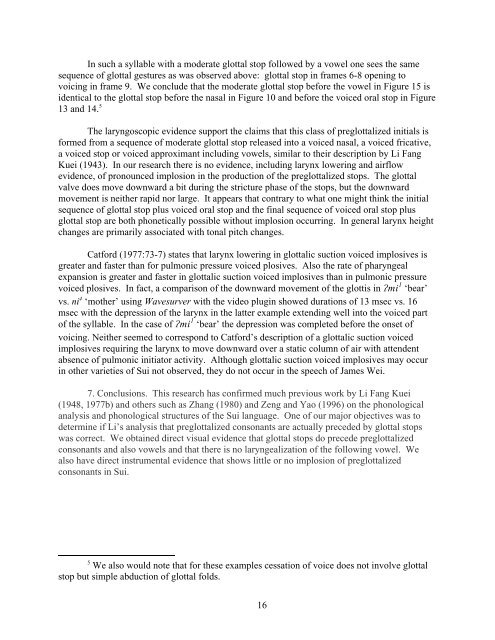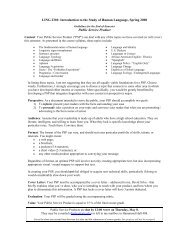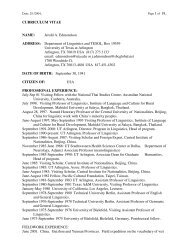1 A phonetic study of the Sui consonants and tones Jerold A ...
1 A phonetic study of the Sui consonants and tones Jerold A ...
1 A phonetic study of the Sui consonants and tones Jerold A ...
Create successful ePaper yourself
Turn your PDF publications into a flip-book with our unique Google optimized e-Paper software.
In such a syllable with a moderate glottal stop followed by a vowel one sees <strong>the</strong> same<br />
sequence <strong>of</strong> glottal gestures as was observed above: glottal stop in frames 6-8 opening to<br />
voicing in frame 9. We conclude that <strong>the</strong> moderate glottal stop before <strong>the</strong> vowel in Figure 15 is<br />
identical to <strong>the</strong> glottal stop before <strong>the</strong> nasal in Figure 10 <strong>and</strong> before <strong>the</strong> voiced oral stop in Figure<br />
13 <strong>and</strong> 14. 5<br />
The laryngoscopic evidence support <strong>the</strong> claims that this class <strong>of</strong> preglottalized initials is<br />
formed from a sequence <strong>of</strong> moderate glottal stop released into a voiced nasal, a voiced fricative,<br />
a voiced stop or voiced approximant including vowels, similar to <strong>the</strong>ir description by Li Fang<br />
Kuei (1943). In our research <strong>the</strong>re is no evidence, including larynx lowering <strong>and</strong> airflow<br />
evidence, <strong>of</strong> pronounced implosion in <strong>the</strong> production <strong>of</strong> <strong>the</strong> preglottalized stops. The glottal<br />
valve does move downward a bit during <strong>the</strong> stricture phase <strong>of</strong> <strong>the</strong> stops, but <strong>the</strong> downward<br />
movement is nei<strong>the</strong>r rapid nor large. It appears that contrary to what one might think <strong>the</strong> initial<br />
sequence <strong>of</strong> glottal stop plus voiced oral stop <strong>and</strong> <strong>the</strong> final sequence <strong>of</strong> voiced oral stop plus<br />
glottal stop are both <strong>phonetic</strong>ally possible without implosion occurring. In general larynx height<br />
changes are primarily associated with tonal pitch changes.<br />
Catford (1977:73-7) states that larynx lowering in glottalic suction voiced implosives is<br />
greater <strong>and</strong> faster than for pulmonic pressure voiced plosives. Also <strong>the</strong> rate <strong>of</strong> pharyngeal<br />
expansion is greater <strong>and</strong> faster in glottalic suction voiced implosives than in pulmonic pressure<br />
voiced plosives. In fact, a comparison <strong>of</strong> <strong>the</strong> downward movement <strong>of</strong> <strong>the</strong> glottis in �mi 1 ‘bear’<br />
vs. ni 4 ‘mo<strong>the</strong>r’ using Wavesurver with <strong>the</strong> video plugin showed durations <strong>of</strong> 13 msec vs. 16<br />
msec with <strong>the</strong> depression <strong>of</strong> <strong>the</strong> larynx in <strong>the</strong> latter example extending well into <strong>the</strong> voiced part<br />
<strong>of</strong> <strong>the</strong> syllable. In <strong>the</strong> case <strong>of</strong> �mi 1 ‘bear’ <strong>the</strong> depression was completed before <strong>the</strong> onset <strong>of</strong><br />
voicing. Nei<strong>the</strong>r seemed to correspond to Catford’s description <strong>of</strong> a glottalic suction voiced<br />
implosives requiring <strong>the</strong> larynx to move downward over a static column <strong>of</strong> air with attendent<br />
absence <strong>of</strong> pulmonic initiator activity. Although glottalic suction voiced implosives may occur<br />
in o<strong>the</strong>r varieties <strong>of</strong> <strong>Sui</strong> not observed, <strong>the</strong>y do not occur in <strong>the</strong> speech <strong>of</strong> James Wei.<br />
7. Conclusions. This research has confirmed much previous work by Li Fang Kuei<br />
(1948, 1977b) <strong>and</strong> o<strong>the</strong>rs such as Zhang (1980) <strong>and</strong> Zeng <strong>and</strong> Yao (1996) on <strong>the</strong> phonological<br />
analysis <strong>and</strong> phonological structures <strong>of</strong> <strong>the</strong> <strong>Sui</strong> language. One <strong>of</strong> our major objectives was to<br />
determine if Li’s analysis that preglottalized <strong>consonants</strong> are actually preceded by glottal stops<br />
was correct. We obtained direct visual evidence that glottal stops do precede preglottalized<br />
<strong>consonants</strong> <strong>and</strong> also vowels <strong>and</strong> that <strong>the</strong>re is no laryngealization <strong>of</strong> <strong>the</strong> following vowel. We<br />
also have direct instrumental evidence that shows little or no implosion <strong>of</strong> preglottalized<br />
<strong>consonants</strong> in <strong>Sui</strong>.<br />
5<br />
We also would note that for <strong>the</strong>se examples cessation <strong>of</strong> voice does not involve glottal<br />
stop but simple abduction <strong>of</strong> glottal folds.<br />
16





